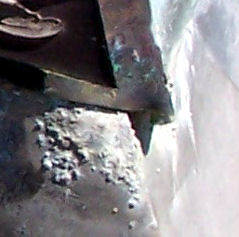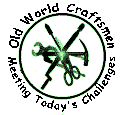 |
ENVIRONMENTAL AFFECTS: COPPER
Our Own Observation Regarding:"...fundamental ignorance that exists in the roofing trades when dissimilar metals are mixed..."
|

Above: Our Own Observation:"...run-off from Cedar will degrade Copper flashings." |
The following is supplied for information purposes only. Make your own decisions: Before specifying any metal, consider the environment and the possible effects associated with a particular metal, given the environment within which, it is expected to survive.
NRCA Publication (National Roofing Contractor Association)
Environmental corrosion of copper
What can slow corrosion on roofs?
by Donald Baerman, AIA, CSI
Editor's note: Following are the author's opinions about copper corrosion based on his observations. Views expressed are not necessarily those of NRCA.
Photos courtesy of Donald Baerman.
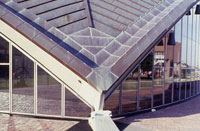 |
||||
Photo 1: The all-copper roof system on Kresge Auditorium at the Massachusetts Institute of Technology, Boston.
Copper sheet metal has been and continues to be a beautiful, durable roofing material. Copper interacts with the environment to form a patina that protects itself from further corrosion, and the color of uniform patina is one of the glories of architectural roof systems.
However, during the past 40 years, especially the past two decades, I have observed rapid corrosion of copper and lead-coated copper roofing and flashing materials exposed to rainwater runoff from other building surfaces and roof surfaces. The phenomenon I describe is something that isn't yet conventional wisdom in the roofing industry, but you should be aware of this problem.
Since first becoming aware of the problem in Connecticut, where I live, I have looked for similar occurrences in other parts of the United States. I have observed copper corrosion as far north as St. Johnsbury, Vt., and St. John, New Brunswick, and as far south as Asheville, N.C. In Chicago and cities west of it, I haven't seen the same sort of corrosion because of a lower concentration of acid aerosol and acid rain.
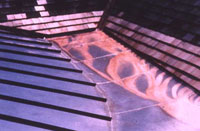 PPhoto 2: This photo shows corrosion on a low-slope copper roof system in Westchester County, N.Y., that receives runoff from a steep-slope cedar shingle roof system. Note there is no corrosion on the low-slope copper roof system receiving runoff from the steep-slope copper roof system.
PPhoto 2: This photo shows corrosion on a low-slope copper roof system in Westchester County, N.Y., that receives runoff from a steep-slope cedar shingle roof system. Note there is no corrosion on the low-slope copper roof system receiving runoff from the steep-slope copper roof system.
Based on systematic measurements and observations, I have discovered causes of copper corrosion, as well as ways to mitigate it. I fastened three sheets of copper on my office's asphalt shingle roof system and tried various methods to protect them from corrosion. I also measured the pH of rain water and dew draining from roofs. Following are my findings.
Experience
By observation, I discovered in addition to geographic location, the location of copper on a building is a major contributor to corrosion. Copper located below masonry materials doesn't seem to be affected, and copper below a roof made of thick marble slabs is unaffected. All-copper roof systems similar to the one on Kresge Auditorium at the Massachusetts Institute of Technology, Boston, also are unaffected. (See Photo 1.) But copper located so it receives runoff from other materials, such as aluminum roofing materials, glass, membrane roofing materials and most steep-slope roofing materials, corrodes. Copper located below cedar shingles especially is vulnerable, probably because of acid extractives in the wood. (See Photo 2.)
Although the acidity of rain in the eastern
part of the United States is high (low pH), rain by itself isn't acidic enough
to harm copper. This is shown by the intact patina seen on many copper roof
systems. The problem occurs when the film of acid from acid aerosol and acid
rain residue is dissolved by dew, mist and other conditions that don't dilute
the acid enough to render it harmless. Copper subject to runoff from other materials
displays a nearly uniform patina after periods of frequent rain, but the patina
deteriorates in periods of dew and mist without rain.
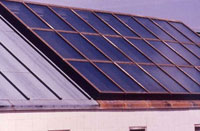
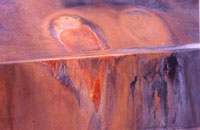 Photos 3 and 4: These photos show the copper roof system with a glass and aluminum skylight on Middlebury Elementary School, Middlebury, Conn. Note the corrosion is confined to the copper flashing under the skylight.
Photos 3 and 4: These photos show the copper roof system with a glass and aluminum skylight on Middlebury Elementary School, Middlebury, Conn. Note the corrosion is confined to the copper flashing under the skylight.
The most severe corrosion, indicated by shiny, unpatinated copper, occurs during clear nights in summer when radiation cooling of a roof system causes water vapor to condense on the roof. Under that and similar conditions, the acid-laden condensed water runs onto the copper in rivulets that easily can be seen. I have taken samples of dew from my house's asphalt shingle roof system and found the acid to be about 10 times as concentrated (one unit pH lower) as that of rain.
One of the clearest demonstrations of copper corrosion caused by acid residue runoff occurs on a Connecticut school's copper roof system that has a skylight. The roof covering on both sides of the skylight is copper, and the skylight is glass and aluminum with a simulated bronze finish. The narrow flashing below the skylight is copper. Photos 3 and 4 show severe corrosion of the copper flashing below the skylight and no corrosion of the adjoining copper.
Avoiding corrosion
Because all-copper roof systems do not corrode rapidly, there is no need for special corrosion-protection provisions when designing and constructing them. There also is no need for special protection if moisture on copper drains onto other roofing materials or other materials' moisture doesn't drain onto copper. Only when a design allows acidic water from other materials to drain onto copper does copper corrode. When this occurs, other methods to avoid corrosion should be investigated.
 Photo 5: This is a magnified photo of an open-front rainwater leader showing copper corrosion. Note the corrosion pits. The gold-colored areas are bare copper; black areas probably are copper oxide or copper sulfide; blue and green areas probably are copper sulfate.
Photo 5: This is a magnified photo of an open-front rainwater leader showing copper corrosion. Note the corrosion pits. The gold-colored areas are bare copper; black areas probably are copper oxide or copper sulfide; blue and green areas probably are copper sulfate.
Coating
Unfortunately, avoiding copper corrosion by coating copper does not appear to perform well in most cases. I have seen lead on lead-coated copper corrode to expose the copper only one year or a few years after installation. Asphalt mastic coating does not perform well and makes the detection of leaks difficult by hiding them. In one instance I've seen, on a clay tile roof system in Greenwich, Conn., a proprietary polyurethane coating has performed well. But a coating must be completely free of voids and pinholes to avoid corrosion, and it must be inspected and renewed periodically. Using a copper gutter as a base for a single-ply or modified bitumen roof membrane also has worked well but only when the membrane is applied properly and carefully.
Redundancy
Avoiding copper corrosion by redundancy is a reasonable design method. A flexible material, such as a single-ply roof membrane or self-adhering modified bitumen flexible flashing, can be installed as the functional flashing with copper over it.
In one instance, when a building owner insisted on using copper under cedar siding, I specified two applications of copper, one over the other, in an area subject to runoff from the cedar siding. The intention was that the upper layer could be replaced after it corroded.
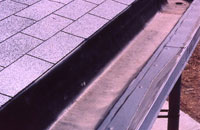 Photo 6: A built-in gutter lined with EPDM rubber.
Photo 6: A built-in gutter lined with EPDM rubber.
The important thing to remember is that redundant, unseen materials must be built with the same care as if they were the only materials. For example, if a redundant gutter-lining material is used, it must have its own drainage system. The best place for the redundant drainage system is where drainage most readily will be noticed, such as above the main entrance to a building. Functioning of a redundant drainage system should trigger repairs to the primary gutter.
Photo 5 shows the complex beauty of copper corrosion compounds. The copper was allowed to continue to corrode by placing a redundant flexible modified bitumen flashing behind the copper three-sided leader. There is an unfortunate tendency to treat each element of a redundant system as if it need not be perfect because the other element exists to help protect the building. In my experience, two imperfect systems are worthless; each element must be treated as if it were the only one.
Chemical protection
Avoiding copper corrosion by chemical protection has promise, but I haven't found the best method yet. Marble chips bonded to copper with epoxy proved to be worthless probably because the exposed area was not large enough.
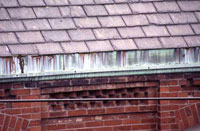 Photo 7: A corroding copper gutter in St. John, New Brunswick.
Photo 7: A corroding copper gutter in St. John, New Brunswick.
Strips of zinc alloy fastened at the point where acidic water drains onto copper have done some good, but zinc alloy has a tendency to develop its own patina and cease to protect copper. This method, however, seems to have great promise. Perhaps pure zinc instead of zinc alloy would perform better because it would enter more readily into a galvanic couple rather than form its own patina.
The best chemical protection method, functionally, I have tried is installing a porous tube of calcium hydroxide (mason's lime) intercepting the acid water flow onto copper. After a few weeks of streaking, the calcium hydroxide doesn't stain copper below it. Unfortunately, the tube may be visually too obtrusive or ugly. Perhaps a perforated copper tube filled with calcium hydroxide treated in a factory to produce a coating of calcium carbonate on the surface would work well. It presumably would have to be replaced periodically. Direct current-cathodic protection ought to work, but I haven't tried it yet.
Other materials
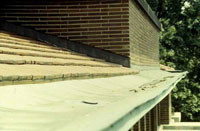 Photo 8: There is no apparent corrosion at the gutters of the Robie House, a Frank Lloyd Wright home in Chicago.
Photo 8: There is no apparent corrosion at the gutters of the Robie House, a Frank Lloyd Wright home in Chicago.
Using another material for vulnerable areas is a way to avoid copper corrosion. I have had good performance from using flexible single-ply roof membranes as gutter liners, and there is no need for expansion joints with such a system. (See Photo 6.) Carefully selected polymer coatings over aluminum sometimes simulate copper so well that it is difficult to tell the difference. Terne-coated stainless steel loses its shine after about one year and resembles lead-coated copper.
There are problems with such substitutions, and the nature of substitute materials must be understood. Copper is highly ductile, fabricator-friendly and easily soldered. A joint design may have to be changed if a metal other than copper is used. Sealed, riveted joints may be required in place of solder for aluminum, for example, and stainless steel is not ductile.
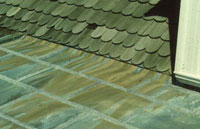 Photo 9: Corrosion on a low-slope copper roof system below cedar shingles in Greenwich, Conn.
Photo 9: Corrosion on a low-slope copper roof system below cedar shingles in Greenwich, Conn.
Clean air aspiration
If air and rain were not acidic, copper roofing and flashing would corrode much more slowly. Don't hold your breath for this to happen in the East. To avoid corrosion problems, install or design copper roof systems in parts of the United States not affected by acid aerosol and acid rain.
Ignore the problem
Some roofing professionals like to think copper corrosion doesn't exist because, even under the most adverse conditions, corrosion proceeds slowly enough that leaks don't occur for the first 10 years or 20 years after construction. In some states with statute of limitations laws, an architect, engineer and contractor may be protected from legal action when the problems occur after the statute of limitations comes into effect.
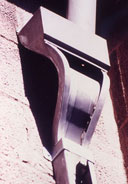 Photo 10: An open-face leader head fabricated of terne-coated stainless steel.
Photo 10: An open-face leader head fabricated of terne-coated stainless steel.
However, the problem does exist. Although copper roof systems not subject to acid corrosion endure for six decades or more, I have seen corroded holes in copper flashings on buildings within 15 years of construction. The holes can result in leaks into buildings?often at valleys and other places that especially are harmful and difficult to repair. In addition, the visual evidence of corrosion is apparent to those who care to look.
Signs
Copper corrosion is an unsightly problem on the East Coast. But fortunately, one of the many advantages of copper roofing and flashings is that they automatically send distress calls alerting building owners to their problems. Bright copper areas on a roof indicate corrosion is occurring, and owners can see the problems simply by looking at their roofs. By turning shiny, the copper is asking its owner to come to its aid and allow it to be beautiful again.
Donald Baerman practices architecture in New England and teaches at the Yale School of Architecture, New Haven, Conn.
? Copyright 2006 National Roofing Contractors Association
